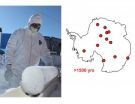(Press-News.org) Boulder, Colo., USA – A trio of paleontologists has discovered a remarkable new tracksite in Alaska's Denali National Park filled with duck-billed dinosaur footprints -- technically referred to as hadrosaurs -- that demonstrates they not only lived in multi-generational herds but thrived in the ancient high-latitude, polar ecosystem. The paper provides new insight into the herd structure and paleobiology of northern polar dinosaurs in an arctic greenhouse world.
The article, "Herd structure in Late Cretaceous polar dinosaurs: A remarkable new dinosaur tracksite, Denali National Park, Alaska, USA," was written for Geology by lead author Anthony R. Fiorillo, curator of earth sciences at the Perot Museum of Nature and Science, and co-authors Stephen Hasiotis of the University of Kansas and Yoshitsugu Kobayashi of the Hokkaido University Museum.
"Denali is one of the best dinosaur footprint localities in the world. What we found that last day was incredible -- so many tracks, so big and well preserved," said Fiorillo. "Many had skin impressions, so we could see what the bottom of their feet looked like. There were many invertebrate traces -- imprints of bugs, worms, larvae and more -- which were important because they showed an ecosystem existed during the warm parts of the years."
**FEATURED ARTICLE**
Herd structure in Late Cretaceous polar dinosaurs: A remarkable new dinosaur tracksite, Denali National Park, Alaska, USA
Anthony R. Fiorillo et al., Perot Museum of Nature and Science, 2201 North Field Street, Dallas, Texas 75201, USA. Published online 30 June 2014; http://dx.doi.org/10.1130/G35740.1
Other GEOLOGY articles (see below) cover such topics as
1. The beneficial effect of Saharan dust in the Bahamas;
2. Geochemical fingerprinting of 25 trans-Atlantic dust events from North Africa to Barbados;
3. Study of shark teeth from Banks Island, NWT, Canada, shows that in the Eocene Arctic Ocean, sharks were abundant even in lower-saline conditions; and
4. Sample analysis from the largest volcanic eruption of the 20th century: the 1912 Novarupta eruption, Alaska.
GEOLOGY articles published online ahead of print can be accessed online at http://geology.gsapubs.org/content/early/recent. All abstracts are open-access at http://geology.gsapubs.org/; representatives of the media may obtain complimentary articles by contacting Kea Giles at the address above.
Please discuss articles of interest with the authors before publishing stories on their work, and please make reference to GEOLOGY in articles published. Contact Kea Giles for additional information or assistance.
Non-media requests for articles may be directed to GSA Sales and Service, gsaservice@geosociety.org.
The fertilization of the Bahamas by Saharan dust: A trigger for carbonate precipitation?
P.K. Swart et al., Marine Geology and Geophysics, Rosenstiel School of Marine and Atmospheric Sciences, University of Miami, Miami, Florida 33149, USA. Published online 30 June 2014; http://dx.doi.org/10.1130/G35744.1.
It has long been known the dust from Africa causes hazy sunsets and dirty cars during certain periods of the year in the south-eastern United States. However, this same dust has a beneficial effect on the shallow waters of the Bahamas. Here it provides iron to photosynthesizing bacteria which in turn fix N2 from the atmosphere and provides nitrogen to all of the biological communities. Evidence for this is present in the ratio of 15N/14N of the sedimentary organic material which is virtually indistinguishable from atmospheric values. The photosynthetic activity of the cyanobacteria in turn induces the precipitation of calcium carbonate in the shallow waters producing large amount of carbonate mud which is swept into deeper waters where it accumulates building and expanding the platform towards the west. It might be speculated that periodic increases in the supplies of dust through time have in turn been responsible for increased deposition of carbonate sediments and enlargement of the Bahamas.
Geochemical fingerprinting of trans-Atlantic African dust based on radiogenic Sr-Nd-Hf isotopes and rare earth element anomalies
Ali Pourmand et al., Neptune Isotope Laboratory, Dept. of Marine Geosciences, Rosenstiel School of Marine and Atmospheric Science, University of Miami, 4600 Rickenbacker Causeway, Miami, Florida 33149, USA. Published online 30 June 2014; http://dx/doi.org/10.1130/G35624.1
Mineral dust is an important component of Earth's climate system and biogeochemical cycles on a global scale. In order to understand the relationship between climate processes in the source areas and the properties of aerosols at distant receptor sites, we must be able to identify the source provenance of dust. We studied the geochemical composition of 25 trans-Atlantic dust events from North Africa to the Caribbean island of Barbados between 2003 and 2011 to investigate the possibility of tracking aerosols to their source origin. We find systematic differences between the geochemical composition of individual dust events, and the first evidence for seasonal shifts in dust source activity and transport between the months of May-September compared with November-April over the decade of study. These results indicate that coherent geochemical source signatures of trans-Atlantic dust can be preserved even after transport across thousands of kilometers. In the absence of geochemical data in aerosols over potential source areas in North Africa, however, it is difficult to make a direct comparison between aerosols over Barbados and the source origins. Nevertheless, our data suggests that many aerosol samples from Barbados are lined to sources in Mali and sub-Saharan regions.
Evidence from shark teeth for a brackish Arctic Ocean in the Eocene greenhouse
Sora L. Kim et al., Current Address: Dept. of Geophysical Sciences, University of Chicago , 5734 S. Ellis Avenue, Chicago, Illinois 60637, USA (also Dept. of Geology & Geophysics, University of Wyoming, 1000 E. University Drive #3006, Laramie, Wyoming 82071, USA). Published online 30 June 2014; http://dx.doi.org/10.1130/G35675.1.
Temperatures are rising in the Arctic at twice the global rate, affecting the sensitive hydrological cycle with increased freshwater inputs to the ocean. A deep-time analogue often used to understand and predict global warming impacts is the early to middle Eocene greenhouse (about 38 to 53 million years ago). Although the terrestrial Arctic during this interval is well documented, marine records are rare and largely based on one central Arctic Ocean site (Lomonosov Ridge). Kim et al. estimate a mean paleosalinity of ~13 PSU for coastal waters of the western Arctic Ocean by analyzing the oxygen isotope composition of Eocene shark teeth from Banks Island, NWT, Canada, and incorporated these values into a salinity model. This paleo-salinity is substantially lower than others for the Eocene central Arctic Ocean (21 to 25 PSU) and today's Arctic Ocean (32 to 35 PSU), but similar to Louisiana's Lake Pontchartrain. This is the first salinity estimate for the western Arctic Ocean during Eocene time and, when considered with prior results from the central Arctic Ocean, suggests a reduced surface salinity but larger salinity gradient (~10 PSU) across the Arctic Ocean during the Eocene greenhouse. From an ecologic perspective, while today's lamniform sharks (e.g., sand tigers, thresher, and great white sharks) are largely intolerant of low salinity, Eocene species were abundant in the brackish Arctic Ocean, suggesting their past environmental tolerances were much greater than today.
Explosive to effusive transition during the largest volcanic eruption of the 20th century (Novarupta 1912, Alaska)
Chinh T. Nguyen et al., Dept. of Earth Science, Rice University, Houston, Texas 77005, USA. Published online 30 June 2014; http://dx.doi.org/10.1130/G35593.1
Silicic volcanic eruptions commonly show abrupt shifts between violently explosive episodes and a gently effusive lava dome. It has been a subject of debate whether the gas loss through inter-connected permeable networks (outgassing) controls these transitions. Sample analysis from the A.D. 1912 Novarupta eruption, Alaska, shows that the degree of vesicle inter-connectivity (measured as the ratio of connected to total vesicle volume fraction) decreases with phenocryst content and increases with eruption intensity. Permeabilities of explosive samples show a weak dependence on vesicle volume fraction. Dome samples are not significantly different in permeability, but are of lower vesicle volume fraction. Quantitative analysis indicates that outgassing alone was insufficient to affect the transition to effusive activity. Rather, the change from explosive to effusive activity was probably a consequence of high versus low magma ascent rates.
Ammonite extinction and nautilid survival at the end of the Cretaceous
Neil H. Landman et al., Division of Paleontology (Invertebrates), American Museum of Natural History, New York, New York 10024, USA. Published online 30 June 2014; http://dx.doi.org/10.1130/G35776.1
One of the puzzles about the end-Cretaceous extinctions is why some organisms disappeared and others survived. A notable example is the differential extinction of ammonites and survival of nautilids, the two groups of co-occurring, externally shelled cephalopods at the end of the Cretaceous. To investigate the role of geographic distribution in explaining this outcome, we compiled a database of all the occurrences of ammonites and the nautilid genus Eutrephoceras in the last 0.5 m.y. of the Maastrichtian. We also included recently published data on ammonite genera that appear to have briefly survived into the Paleocene. Using two metrics to evaluate the geographic range of each genus (first, a convex hull encompassing all of the occurrences of each genus, and second, the maximum distance between occurrences for each genus), we documented that most ammonite genera at the end of the Maastrichtian were restricted in their geographic distribution, possibly making them more vulnerable to extinction. The geographic distribution of those genera that may have briefly survived into the Paleocene is significantly greater than that of non-surviving genera, implying that more broadly distributed genera were more resistant to extinction. This pattern is further emphasized by the broad distribution of Eutrephoceras, which matches that of the most widely distributed ammonites at the end of the Maastrichtian. However, even the most widely distributed ammonites eventually succumbed to extinction, whereas Eutrephoceras survived. Evidently, a broad geographic distribution may have initially protected some ammonites against extinction, but it did not guarantee their survival.
Persistent intermediate water warming during cold stadials in the southeastern Nordic seas during the past 65 k.y.
Mohamed M. Ezat et al., Centre for Arctic Gas Hydrate, Environment and Climate (CAGE), Uit, The Arctic University of Norway, NO-9037 Tromsø, Norway, and Dept. of Geology, Faculty of Science, Beni-Suef University, 62111 Beni-Suef, Egypt. Published online 30 June 2014; http://dx.doi.org/10.1130/G35579.1.
Greenland ice core records reveal millennial-scale climate variability during the last glacial (~100,000 to 10,000 years before present), known as Dansgaard-Oeschger (DO) events. A typical DO cycle (~1500 years) is characterized by an abrupt atmospheric warming of 8 to 16 degrees C from stadial (cold) to interstadial (warm) conditions followed by a gradual cooling and eventually a sudden cooling back to stadial conditions. In the modern Nordic seas, conversion of inflowing warm Atlantic surface water to deep cold water ( END
Denali duck-billed dino tracks
New Geology articles published online ahead of print 30 June 2014
2014-07-07
ELSE PRESS RELEASES FROM THIS DATE:
Babies born to healthy mums worldwide are strikingly similar in size
2014-07-07
Babies' growth in the womb and their size at birth, especially their length, are strikingly similar the world over – when babies are born to healthy, well-educated and well-nourished mothers.
That's the finding of a landmark international study, INTERGROWTH-21st, led by Oxford University researchers, which involved almost 60,000 pregnancies in eight defined urban areas in Brazil, China, India, Italy, Kenya, Oman, the UK and USA.
Worldwide there are wide disparities in the average size of babies at birth. This has significant consequences for future health, as small ...
Researchers uncover new knowledge about our intestines
2014-07-06
Researchers from DTU Systems Biology have mapped 500 previously unknown microorganisms in human intestinal flora as well as 800 also unknown bacterial viruses (also called bacteriophages) which attack intestinal bacteria.
To map the microorganisms, the researchers have developed a new principle for analysing DNA sequence data, which they have named the co-abundance principle. A principle which basically assumes that different pieces of DNA from the same organism will occur in the same amount in a sample, and that this amount will vary over a series of samples.
"Using ...
'Nanojuice' could improve how doctors examine the gut
2014-07-06
BUFFALO, N.Y. – Located deep in the human gut, the small intestine is not easy to examine. X-rays, MRIs and ultrasound images provide snapshots but each suffers limitations.
Help is on the way.
University at Buffalo researchers are developing a new imaging technique involving nanoparticles suspended in liquid to form "nanojuice" that patients would drink. Upon reaching the small intestine, doctors would strike the nanoparticles with a harmless laser light, providing an unparalleled, non-invasive, real-time view of the organ.
Described July 6 in the journal Nature Nanotechnology, ...
Discovery provides insights on how plants respond to elevated CO2 levels
2014-07-06
Biologists at UC San Diego have solved a long-standing mystery concerning the way plants reduce the numbers of their breathing pores in response to rising carbon dioxide levels in the atmosphere.
In a paper published in this week's early online edition of Nature, they report the discovery of a new genetic pathway in plants, made up of four genes from three different gene families that control the density of breathing pores—or "stomata"—in plant leaves in response to elevated CO2 levels.
Their discovery should help biologists better understand how the steadily increasing ...
Rewriting the history of volcanic forcing during the past 2,000 years
2014-07-06
RENO – A team of scientists led by Michael Sigl and Joe McConnell of Nevada's Desert Research Institute (DRI) has completed the most accurate and precise reconstruction to date of historic volcanic sulfate emissions in the Southern Hemisphere.
The new record, described in a manuscript published today in the online edition of Nature Climate Change, is derived from a large number of individual ice cores collected at various locations across Antarctica and is the first annually resolved record extending through the Common Era (the last 2,000 years of human history).
"This ...
Global toolkit to diagnose menopause
2014-07-06
Created at Monash University, the world's first toolkit is designed for GPs to use with women from the age of 40. Thought to be the first of its kind, researchers say the toolkit has the potential to help manage menopausal conditions for women globally.
The Practitioner Toolkit for Managing the Menopause, which includes a diagnostic tool, as well as a compendium of approved hormone therapies, is published today in the journal, Climacteric.
Led by Professor Susan Davis, the research team from the School of Public Health and Preventative Medicine, combined existing research ...
The Lancet: Sierra Leone researchers call for improved health surveillance and communication around Ebola crisis
2014-07-05
Researchers working in Sierra Leone today [Saturday 5 July] suggest priority actions needed to tackle the ongoing Ebola crisis in West Africa. In a letter to The Lancet, the researchers call for improvements in access to diagnostic technologies and health-care resources, as well as improved disease surveillance and health communication.
At present, there is little incentive for patients to seek professional diagnosis of suspected Ebola, say the authors, with most people with febrile (fever-causing) illnesses in Sierra Leone treated at home, and the true extent of the ...
The Lancet: New trial suggests cheaper drugs for common heart attack procedure could improve outcomes and save health budgets millions
2014-07-05
A new study published in The Lancet compares outcomes for two drugs used to prevent blood clot formation during emergency heart attack treatment. The study suggests that use of one of the drugs, heparin, could result in improved outcomes (such as a reduced rate of repeat heart attacks), compared to the other drug tested, bivalirudin, which is in widespread use in high-income countries, and is around 400 times more expensive than heparin.
The results of the HEAT-PPCI trial suggest that systematic use of heparin rather than bivalirudin after primary percutaneous coronary ...
Association found between high cholesterol and breast cancer
2014-07-04
This news release is available in Spanish.
Barcelona, 4 July 2014: An association between high blood cholesterol and breast cancer has been found in a study of more than 1 million patients over a 14 year time period in the UK. The research will be presented today at Frontiers in CardioVascular Biology (FCVB) 2014 in Barcelona, Spain. The meeting is organised by the Council on Basic Cardiovascular Science of the European Society of Cardiology (ESC) in collaboration with 13 European cardiovascular science societies.
http://spo.escardio.org/SessionDetails.aspx?eevtid=65&sessId=13301&subSessId=3494
Dr ...
First evidence for painless atrial fibrillation treatment
2014-07-04
Barcelona, 4 July 2014: The first evidence for a shockless treatment for atrial fibrillation (AF) will be presented today at Frontiers in CardioVascular Biology (FCVB) 2014 in Barcelona, Spain. The meeting is organised by the Council on Basic Cardiovascular Science of the European Society of Cardiology (ESC) in collaboration with 13 European cardiovascular science societies. http://spo.escardio.org/SessionDetails.aspx?eevtid=65&sessId=13104
Dr Brian O. Bingen, first author, said: "AF is the most common cardiac arrhythmia. Symptoms range from the feeling of fish flapping ...
LAST 30 PRESS RELEASES:
Numbers in our sights affect how we perceive space
SIMJ announces global collaborative book project in commemoration of its 75th anniversary
Air pollution exposure and birth weight
Obstructive sleep apnea risk and mental health conditions among older adults
How talking slows eye movements behind the wheel
The Ceramic Society of Japan’s Oxoate Ceramics Research Association launches new international book project
Heart-brain connection: international study reveals the role of the vagus nerve in keeping the heart young
Researchers identify Rb1 as a predictive biomarker for a new therapeutic strategy in some breast cancers
Survey reveals ethical gaps slowing AI adoption in pediatric surgery
Stimulant ADHD medications work differently than thought
AI overestimates how smart people are, according to HSE economists
HSE researchers create genome-wide map of quadruplexes
Scientists boost cell "powerhouses" to burn more calories
Automatic label checking: The missing step in making reliable medical AI
Low daily alcohol intake linked to 50% heightened mouth cancer risk in India
American Meteorological Society announces Rick Spinrad as 2026 President-Elect
Biomass-based carbon capture spotlighted in newly released global climate webinar recording
Illuminating invisible nano pollutants: advanced bioimaging tracks the full journey of emerging nanoscale contaminants in living systems
How does age affect recovery from spinal cord injury?
Novel AI tool offers prognosis for patients with head and neck cancer
Fathers’ microplastic exposure tied to their children’s metabolic problems
Research validates laboratory model for studying high-grade serous ovarian cancer
SIR 2026 delivers transformative breakthroughs in minimally invasive medicine to improve patient care
Stem Cell Reports most downloaded papers of 2025 highlight the breadth and impact of stem cell research
Oxford-led study estimates NHS spends around 3% of its primary and secondary care budget on the health impacts of heat and cold in England
A researcher’s long quest leads to a smart composite breakthrough
Urban wild bees act as “microbial sensors” of city health.
New study finds where you live affects recovery after a hip fracture
Forecasting the impact of fully automated vehicle adoption on US road traffic injuries
Alcohol-related hospitalizations from 2016 to 2022
[Press-News.org] Denali duck-billed dino tracksNew Geology articles published online ahead of print 30 June 2014




